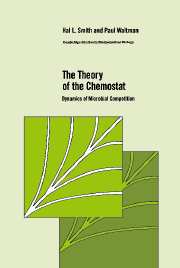Book contents
- Frontmatter
- Contents
- Preface
- 1 The Simple Chemostat
- 2 The General Chemostat
- 3 Competition on Three Trophic Levels
- 4 The Chemostat with an Inhibitor
- 5 The Simple Gradostat
- 6 The General Gradostat
- 7 The Chemostat with Periodic Washout Rate
- 8 Variable-Yield Models
- 9 A Size-Structured Competition Model
- 10 New Directions
- 11 Open Questions
- Appendices
- References
- Author index
- Subject index
9 - A Size-Structured Competition Model
Published online by Cambridge University Press: 07 December 2009
- Frontmatter
- Contents
- Preface
- 1 The Simple Chemostat
- 2 The General Chemostat
- 3 Competition on Three Trophic Levels
- 4 The Chemostat with an Inhibitor
- 5 The Simple Gradostat
- 6 The General Gradostat
- 7 The Chemostat with Periodic Washout Rate
- 8 Variable-Yield Models
- 9 A Size-Structured Competition Model
- 10 New Directions
- 11 Open Questions
- Appendices
- References
- Author index
- Subject index
Summary
Introduction
The models considered in previous chapters of this monograph have ignored the fact that populations of microorganisms contain individuals with differing body size and that individuals of different size have different characteristics. Body size is clearly an important factor in determining an organism's energy requirements and its ability to uptake resources. Furthermore, if an organism can grow as well as reproduce, then it becomes important to determine how the organism allocates its energy resources between growth and reproduction.
Data from [Wi] – particularly figures 3, 6, 8, 10, 18, 19, and 21 – leave no doubt that, at least for certain populations of algae, individual cell volume varies significantly during the course of experiments in the chemostat. These data also suggest that steady-state size distributions are reached which have remarkably stable shapes with respect to changes in the control parameters for the chemostat (flow rates, temperature, CO2).
The purpose of this chapter is to present a model of competition in the chemostat for a single resource that takes these factors into account, and to determine the extent to which these factors influence the outcome of competition. The model presented here is a special case of a more general class of models formulated in [DMKH] and treated in [MD, sec. 1.3]. This simplified model is one of several considered in an elegant paper by Cushing [Cu2]. Most of the results of this chapter are taken from [Cu2].
- Type
- Chapter
- Information
- The Theory of the ChemostatDynamics of Microbial Competition, pp. 208 - 230Publisher: Cambridge University PressPrint publication year: 1995



